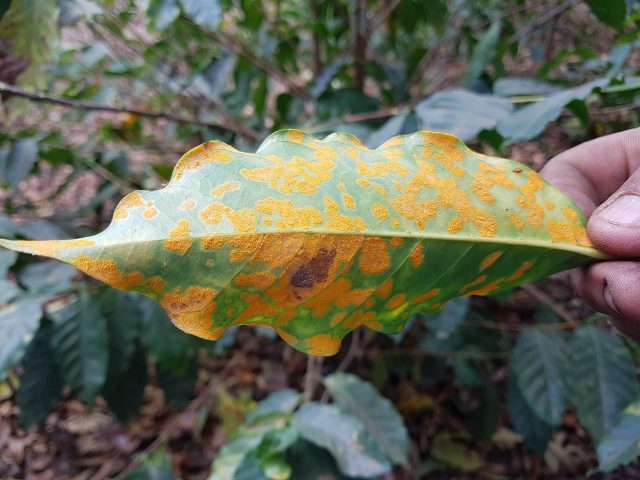26
May
Coffee Leaf Rust Hits Hawai’i, Emergency Fungicide Approved, Hyperparasite Biocontrol Possible

(Beyond Pesticides, May 26, 2021) Coffee leaf rust, caused by a fungus that can devastate fields of coffee plants, and the coffee industry of entire countries, was recently detected on the Hawaiian Islands for the first time. The U.S. Environmental Protection Agency (EPA) acted quickly to approve the emergency use of a synthetic fungicide, but new research conducted in the fungus’ home range shows the promise of a hyperparasite biocontrol.
Caused by the fungus Hemileia vastatrix, coffee leaf rust was first documented in its home range of Africa in the 1860s. By the later part of that decade, it had spread to Sri Lanka, and destroyed the country’s monoculture coffee plantations, which were subsequently replaced with tea cultivation. The disease has now been found in every coffee producing country, but up until late last year, it had never been seen on the Hawaiian Islands.
Thus, Hawaiian coffee farmers are rightly concerned about the disease. In response, EPA permitted the use of a product called Priaxor Xemium, a fungicide consisting of the active ingredients fluxapyroxad and pyraclostrobin, which has been linked to birth and developmental effects, and presents significant hazards to birds and aquatic organisms. “Hawai’i coffee growers now have an added method to combat the coffee leaf rust, which is extremely difficult to manage,” said Phyllis Shimabukuro-Geiser, chairperson of the Hawai’i Board of Agriculture. But while conventional chemical growers may opt to spray hazardous pesticides, organic farmers will look towards less toxic methods of management.
A new study published by a team of researchers from Sweden and Ethiopia shows promising indications for a biologically based approach to addressing H. vastatrix. Scientists began their investigation in Southwestern Ethiopia, the home range of Arabica coffee and its fungal disease. Sixty sites, consisting of 50 by 50m (164 x 164 ft) plots, were analyzed in the region over the course of three years. The sites varied in the level of management intensity, amount of shade provided the coffee plants, and the ecological characteristics surrounding the farmland.
Researchers aimed to catalog the interaction between H. vastatrix and another fungus known as Lecanicillium lecanii. L lecanii is considered a ‘hyperparasite,’ in that it is a parasite that attacks another parasite. Scientists know that the hyperparasite controls the rust fungus, but are not aware how widespread it is distributed, the conditions in which it thrives, and whether may be able to play a role in suppressing the rust in commercial production.
Results of the three-year study show that rust problems are enhanced during dry seasons, while the hyperparasite thrives in wet conditions. “We also found a slight variation in the environmental requirement of the rust and the hyperparasite. The rust can thrive in low moisture conditions whereas the hyperparasite favours areas characterised by moist and shaded habitats,” said Beyene Zewdie, PhD, study coauthor and researcher at Stockholm University to SciDev.Net.
The hyperparasite fared better at higher altitudes, while the rust thrived at lower altitude. And generally, shade grown coffee was able to provide a better habitat for the proliferation of the hyperparasite. “Coffee needs shade and growing the crop under shade could buffer the microclimate around the coffee shrubs,” Dr. Zewdie told SciDev.Net. “Shade also creates a conducive environment for the coffee leaf rust hyperparasite and we need to maximise this potential to make use of the capacity of the hyperparasite to suppress the rust in areas where the two interacting species co-occur.”
Scientists determined that prevalence of the rust fungus increased as management intensity increased. Less intensively managed coffee systems had higher abundance of the hyperparasite.
“The discovery of L. lecanii as a hyperparasite against the coffee rust fungus in a natural environment is a major breakthrough that may have a significant contribution in the management of the coffee leaf rust,” said Bernard Gichimu, PhD of Kenya’s University of Embu to SciDev.Net. “With climate change, the disease has become even more damaging … even in areas that were hitherto known to be less prone to the disease.”
Experts like Dr. Gichimu indicate that management with the rust fungus’ natural control organism could be the favored management method, as fungicides often fail to control the disease due to resistance or misapplication. Any fungicide will of course target both the rust fungus and kill its fungal hyperparasite. “Reduced use of fungicides will also reduce environmental pollution which will be beneficial to the non-target organisms and safe to both the farmers and coffee consumers,” Dr. Gichimu told SciDev.Net.
Previous research on organic coffee production determined that organic farms can foster a range of complex biological interactions that can help manage coffee leaf rust and other coffee plant pests. Rather than reaching for a bottle that would kill both pest and predator alike, all farmers in Hawai’i have the opportunity to show the world how the disease can be managed without toxic fungicides, by enacting preventive practices that increase the habitat conditions for pest predators.
For more information on managing pests through less toxic and biological means, join Beyond Pesticides National Pesticide Forum, which continues each Tuesday until June 15th. It’s not too late to register – visit Beyond Pesticides’ forum webpage to reserve your spot.
All unattributed positions and opinions in this piece are those of Beyond Pesticides.
Source: SciDev.Net, The Maui News, Hawai’i Department of Agriculture, Agriculture, Ecosystems and Environment (peer reviewed journal)










